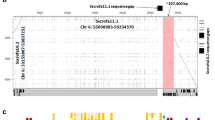Abstract.
CD69 is a type II membrane protein belonging to C-type lectin family receptor, and expressed on activated leukocytes. Pig CD69 was cloned by RT-PCR using degenerate primers. Pig CD69 cDNA contains a 600 bp open reading frame with its predicted polypeptide sequence of 200 amino acids. Pig CD69 has 75%, 67%, and 57% sequence identity with cow, human, and mouse CD69, respectively. A splicing isoform, which lacks exon 2 encoding the transmembrane domain, was detected. Pig CD69 gene is located on Chromosome (Chr) 5q25 where the NKG2D gene was mapped. In RT-PCR analysis, pig CD69 mRNA was detected in activated PBL, NK cells, macrophages, monocytes, and granulocytes, but not in resting cells. The inducers for CD69 gene expression were PMA, PHA, LPS, G7 mAb, PNK-E mAb, PM16–6 mAb and the K562 cell line. Moreover, CD69 mRNA is expressed in bone marrow, spleen, thymus and lymph nodes but not in muscle, mammary gland, or the pig kidney cell line (LLC-PK1). These results indicate that pig Chr 5q25 contains the NK gene complex and CD69 can be used as an activation marker in pig cells of innate as well as acquired immune systems.
Similar content being viewed by others
Author information
Authors and Affiliations
Additional information
Electronic Publication
Rights and permissions
About this article
Cite this article
Yim, D., Sotiriadis, J., Kim, KS. et al. Molecular cloning, expression pattern and chromosomal mapping of pig CD69. Immunogenetics 54, 276–281 (2002). https://doi.org/10.1007/s00251-002-0464-6
Received:
Revised:
Issue Date:
DOI: https://doi.org/10.1007/s00251-002-0464-6




